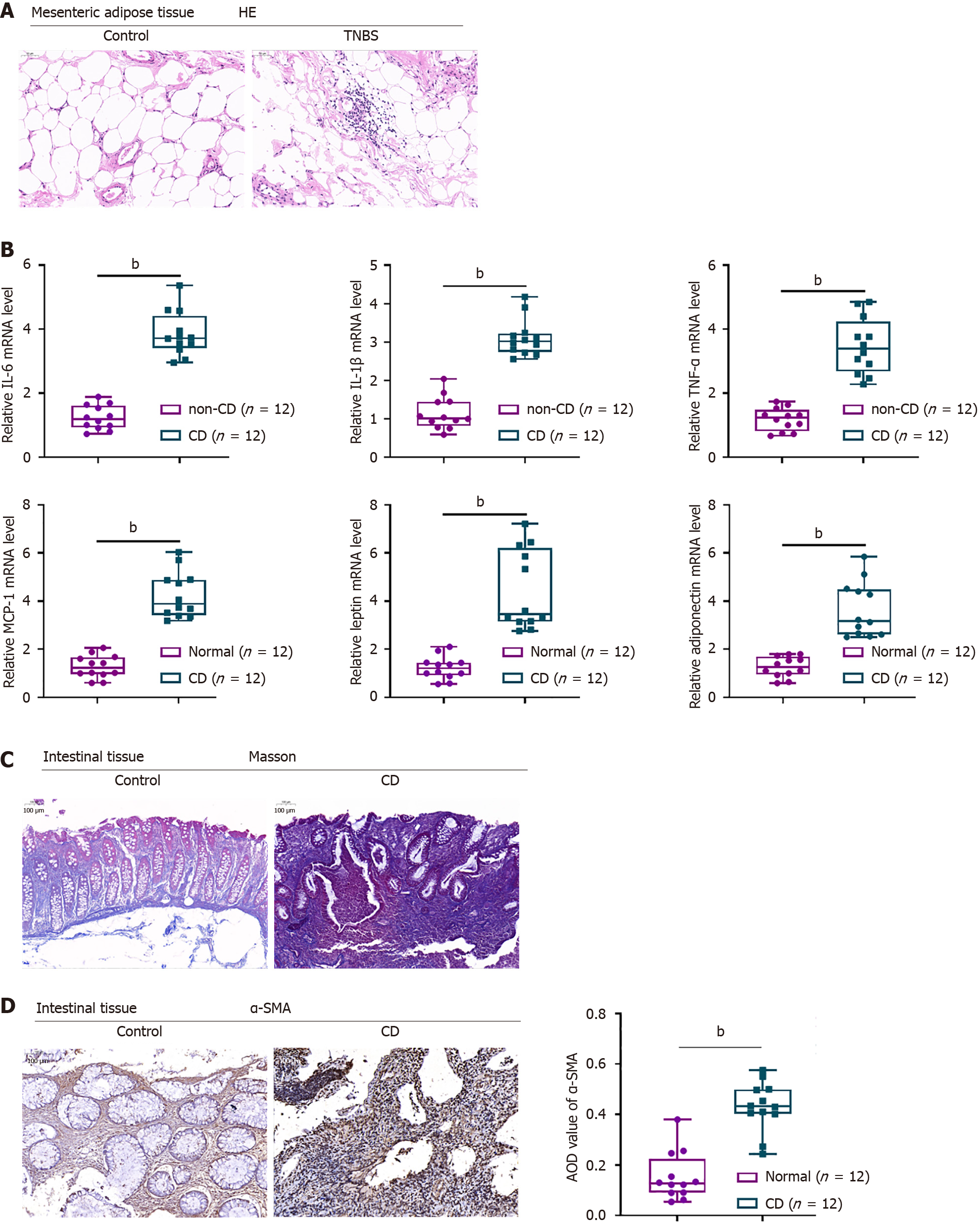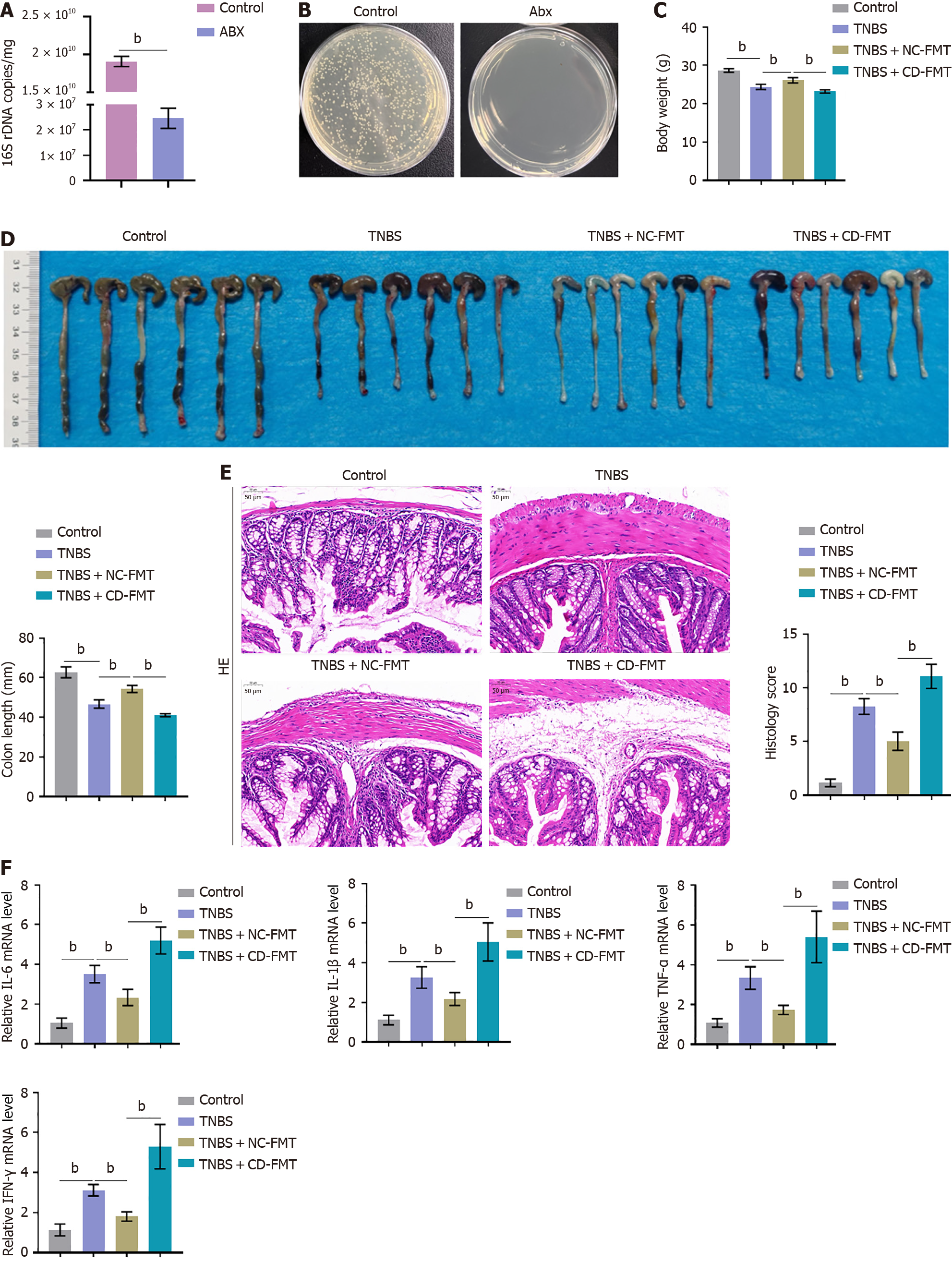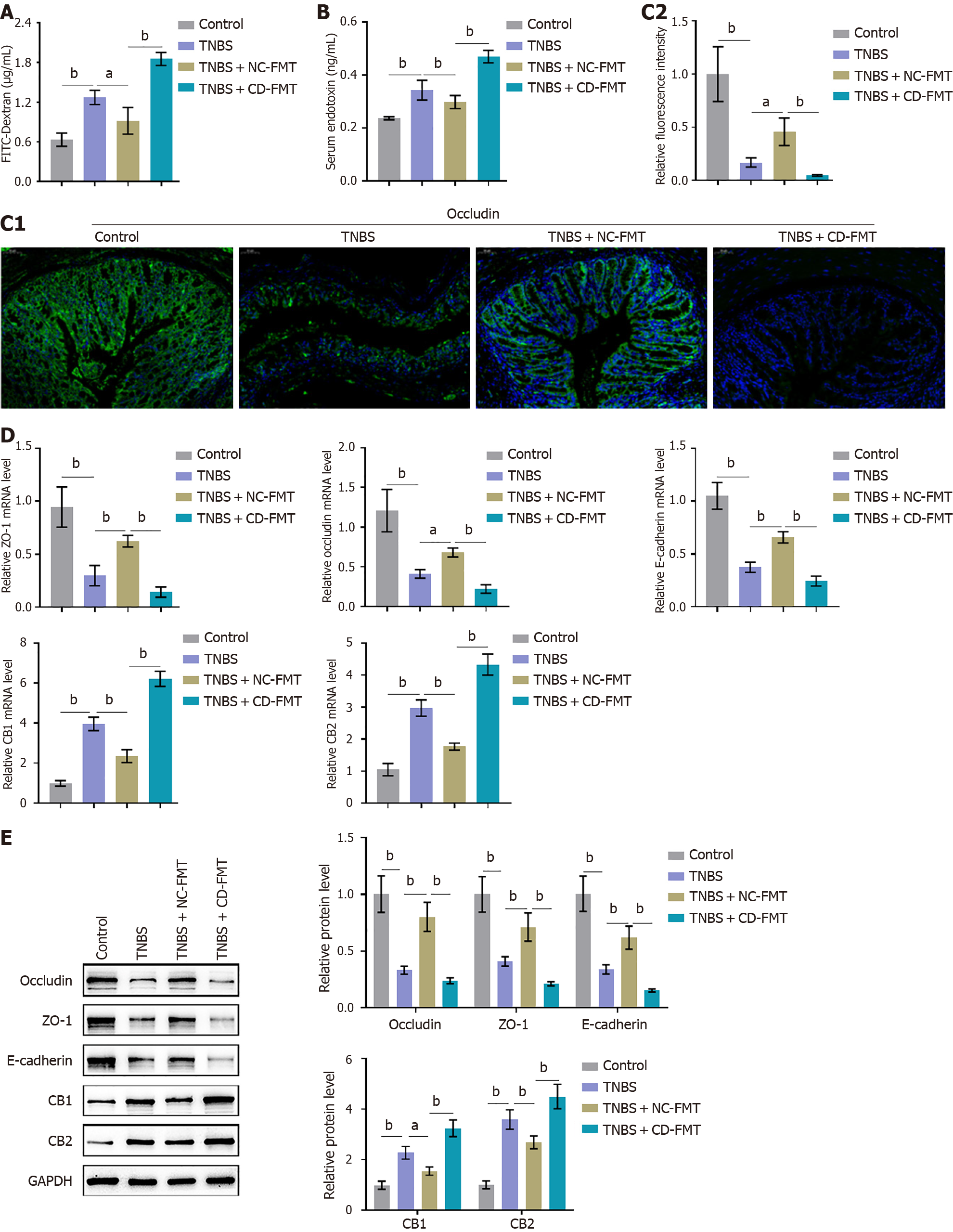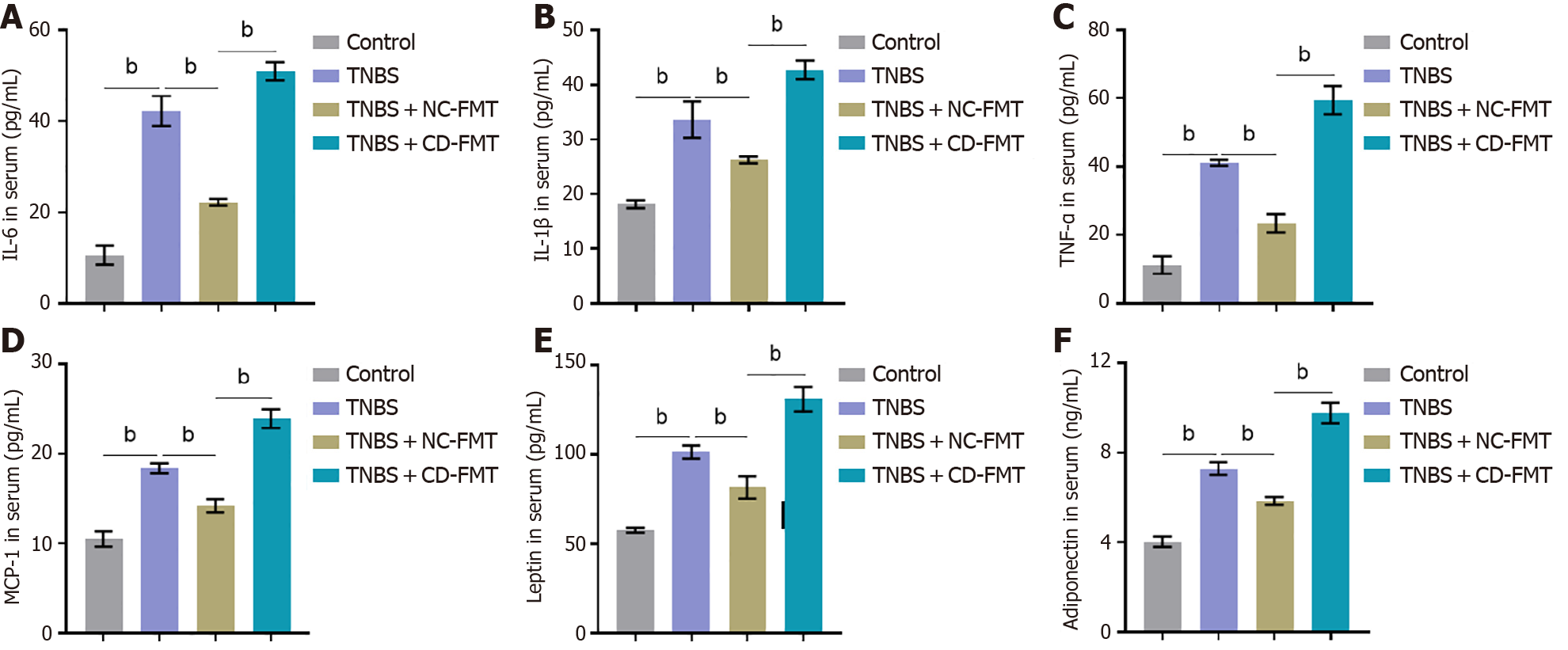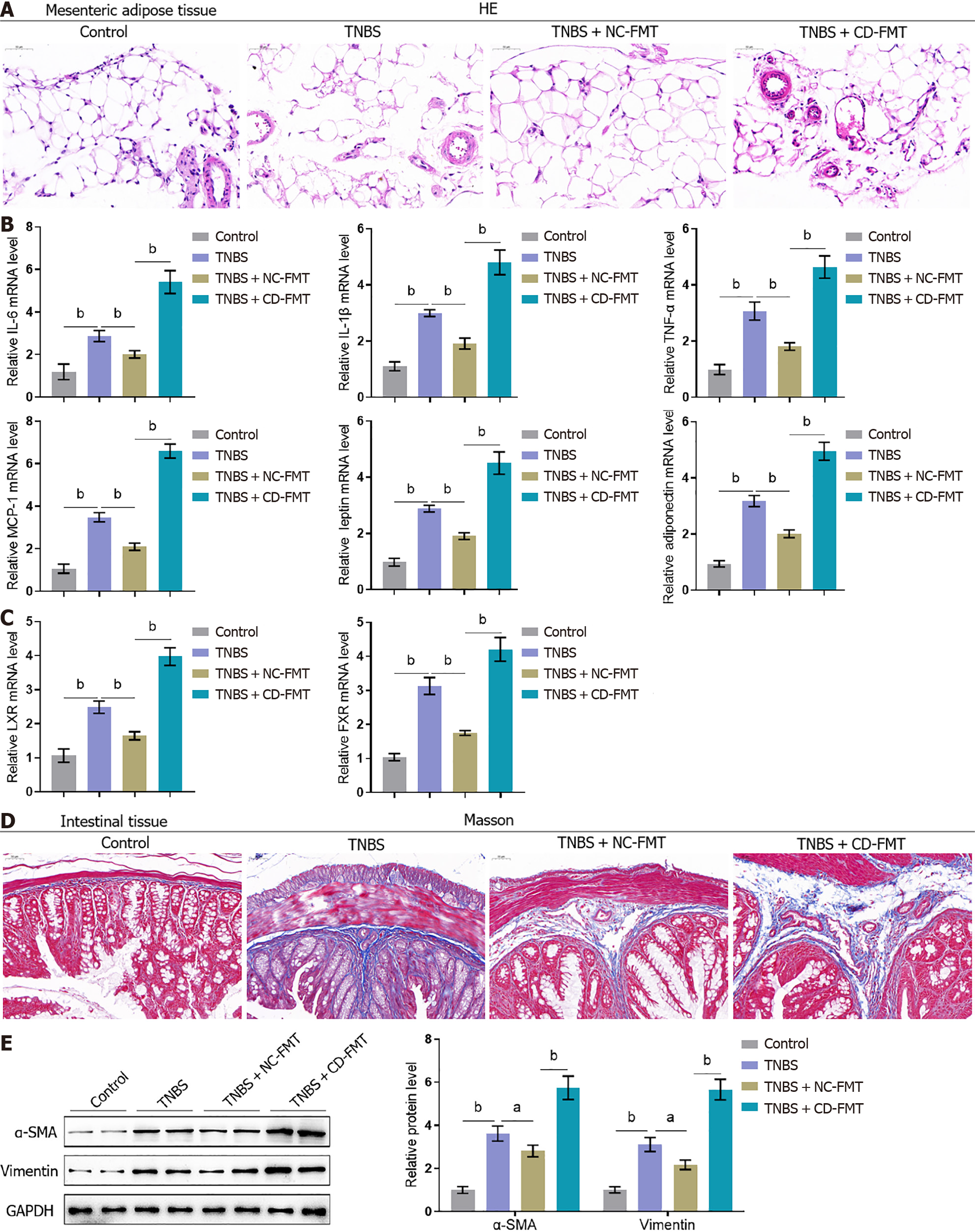Copyright
©The Author(s) 2024.
World J Gastroenterol. Aug 21, 2024; 30(31): 3689-3704
Published online Aug 21, 2024. doi: 10.3748/wjg.v30.i31.3689
Published online Aug 21, 2024. doi: 10.3748/wjg.v30.i31.3689
Figure 1 Histopathological alterations in mesenteric adipose and intestinal tissues of patients with Crohn’s disease.
A: Mesenteric adipose tissues from Crohn’s disease (CD) patients and non-CD subjects stained with hematoxylin-eosin to assess histopathological alterations (× 150); B: Real-time reverse transcriptase-polymerase chain reaction assays of the levels of expression of interleukin-6 (IL-6), IL-1β, tumour necrosis factor alpha, MCP-1, leptin, and adiponectin mRNAs; C: Intestinal tissues from CD patients and non-CD subjects stained with Masson stain to evaluate fibrotic alterations (× 150); D: Immunohistochemical staining of alpha-smooth muscle actin in intestinal tissues from CD patients and non-CD subjects (× 150). Average optical density was quantified using ImageJ software (right panel). n = 12, bP < 0.01 or n = 3, bP < 0.01 by paired t-tests. HE: Hematoxylin and eosin; TNBS: 2,4,6-trinitrobenzene sulfonic acid; CD: Crohn’s disease; TNF-α: Tumour necrosis factor alpha; IL: Interleukin; α-SMA: Alpha-smooth muscle actin; AOD: Average optical density.
Figure 2 Fecal microbiota transplantation into mice with 2,4,6-trinitrobenzene sulfonic acid-induced Crohn’s disease.
A and B: Mice were subjected to antibiotic cleaning to achieve a pseudo germ-free intestinal environment, with the results verified by 16S rRNA sequencing. n = 6. bP < 0.01 by unpaired t-tests; C and D: 2,4,6-trinitrobenzene sulfonic acid (TNBS)-treated mice underwent fetal microbiota transplantation (FMT) from clinically healthy donors or Crohn’s disease patients, and their body weights and colon lengths were monitored; E: Evaluation of histopathological alterations in colon samples by hematoxylin-eosin staining and evaluation of histology scores (× 150); F: Real-time reverse transcriptase-polymerase chain reaction assays of interleukin-6 (IL-6), IL-1β, tumour necrosis factor alpha, and interferon-gamma mRNA expression levels in colon tissue samples. n = 6, bP < 0.01 vs control; bP < 0.01 vs TNBS alone; bP < 0.01 vs TNBS + healthy donor (NC)-FMT, by one-way ANOVA with post-hoc Tukey HSD test. Abx: Antibiotics; TNBS: 2,4,6-trinitrobenzene sulfonic acid; CD: Crohn’s disease; NC: Normal control; FMT: Fetal microbiota transplantation; IFN-γ: Interferon-gamma; TNF-α: Tumour necrosis factor alpha; IL: Interleukin.
Figure 3 Effects of gut microbiota from Crohn’s disease patients on intestinal permeability in mice with 2,4,6-trinitrobenzene sulfonic acid-induced Crohn’s disease.
A: Fluorescein isothiocyanate conjugated-dextran assays of intestinal permeability; B: ELISA assays of serum concentrations of lipopolysaccharide-binding protein to determine serum endotoxin levels; C: Immunofluorescent staining of colon tissues to determine the levels of occludin expression (× 150). Average fluorescence density was quantified using ImageJ software (right panel); D and E: Real-time reverse transcriptase-polymerase chain reaction and immunoblotting assays showing the levels of occludin, ZO-1, E-cadherin, CB1, and CB2 mRNA and protein in colon tissues. n = 6 or 3, bP < 0.01 vs control; aP < 0.05, bP < 0.01 vs 2,4,6-trinitrobenzene sulfonic acid (TNBS) alone; bP < 0.01 vs TNBS + NC-fetal microbiota transplantation, by one-way ANOVA with post-hoc Tukey HSD test. TNBS: 2,4,6-trinitrobenzene sulfonic acid; CD: Crohn’s disease; NC: Normal control; FMT: Fetal microbiota transplantation.
Figure 4 ELISA determinations of serum concentrations of cytokines and adipokines.
A: Interleukin (IL)-6; B: IL-1β; C: Tumour necrosis factor alpha; D: MCP-1; E: Leptin; F: Adiponectin. n = 6, bP < 0.01 vs control; aP < 0.05, bP < 0.01 vs 2,4,6-trinitrobenzene sulfonic acid (TNBS) alone; bP < 0.01 vs TNBS + NC-fetal microbiota transplantation, by one-way ANOVA with post-hoc Tukey HSD test. TNBS: 2,4,6-trinitrobenzene sulfonic acid; CD: Crohn’s disease; NC: Normal control; FMT: Fetal microbiota transplantation.
Figure 5 Effects of gut microbiota from Crohn’s disease patients on the histopathological characteristics of mesenteric adipose and intestinal tissues from mice with 2,4,6-trinitrobenzene sulfonic acid-induced Crohn’s disease.
A: Mesenteric adipose tissues collected from mice were stained with hematoxylin-eosin to assess histopathological alterations (× 150); B and C: Real-time reverse transcriptase-polymerase chain reaction assays of interleukin-6 (IL-6), IL-1β, tumour necrosis factor alpha, MCP-1, leptin, adiponectin, LXR, and FXR mRNA levels in mouse tissues; D: Intestinal tissues from mice stained with Masson stain to evaluate fibrotic alterations (× 150); E: Immunoblotting assays of alpha-smooth muscle actin and vimentin protein levels in mouse intestinal tissues. n = 6 or 3, bP < 0.01 vs control; aP < 0.05, bP < 0.01 vs 2,4,6-trinitrobenzene sulfonic acid (TNBS) alone; bP < 0.01 vs TNBS + NC-fetal microbiota transplantation, by one-way ANOVA with post-hoc Tukey HSD test. TNBS: 2,4,6-trinitrobenzene sulfonic acid; CD: Crohn’s disease; NC: Normal control; FMT: Fetal microbiota transplantation; IFN-γ: Interferon-gamma; TNF-α: Tumour necrosis factor alpha; IL: Interleukin; HE: Hematoxylin and eosin; α-SMA: Alpha-smooth muscle actin.
- Citation: Wu Q, Yuan LW, Yang LC, Zhang YW, Yao HC, Peng LX, Yao BJ, Jiang ZX. Role of gut microbiota in Crohn’s disease pathogenesis: Insights from fecal microbiota transplantation in mouse model. World J Gastroenterol 2024; 30(31): 3689-3704
- URL: https://www.wjgnet.com/1007-9327/full/v30/i31/3689.htm
- DOI: https://dx.doi.org/10.3748/wjg.v30.i31.3689









